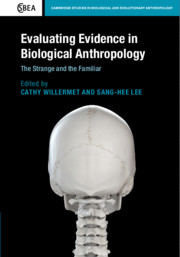Book contents
- Evaluating Evidence in Biological Anthropology
- Cambridge Studies in Biological and Evolutionary Anthropology
- Evaluating Evidence in Biological Anthropology
- Copyright page
- Contents
- Contributors
- Introduction
- Part I The Strange and the Familiar
- Part II (Re)Discovery of Evidence
- 6 (Re)Discovering Paleopathology
- 7 Parsing the Paradox
- 8 Seeing RED
- 9 Paleoanthropology and Analytical Bias
- 10 (Re)Discovering Ancient Hominin Environments
- 11 Discussion and Conclusion
- Index
- References
10 - (Re)Discovering Ancient Hominin Environments
How Stable Carbon Isotopes of Modern Chimpanzee Communities Can Inform Paleoenvironment Reconstruction
from Part II - (Re)Discovery of Evidence
Published online by Cambridge University Press: 01 November 2019
- Evaluating Evidence in Biological Anthropology
- Cambridge Studies in Biological and Evolutionary Anthropology
- Evaluating Evidence in Biological Anthropology
- Copyright page
- Contents
- Contributors
- Introduction
- Part I The Strange and the Familiar
- Part II (Re)Discovery of Evidence
- 6 (Re)Discovering Paleopathology
- 7 Parsing the Paradox
- 8 Seeing RED
- 9 Paleoanthropology and Analytical Bias
- 10 (Re)Discovering Ancient Hominin Environments
- 11 Discussion and Conclusion
- Index
- References
Summary
Since the 1980s, stable carbon isotopes (δ13C) of pedogenic carbonates and fossil tooth enamel have been analyzed to contribute to paleoenvironment and dietary reconstructions of hominin habitats across Africa. Initial studies focused on documenting δ13C values in paleosol and enamel carbonate to link the spreading of arid C4 grasses with the habitat reconstructions of fossil fauna to interpret “open” versus “closed” canopies at fossil-bearing sites or the dietary differences between “grazers” versus “browsers.” While habitat reconstructions of hominin-bearing sites are critical for our interpretations of human evolution, this is just one layer of (re)discovering ancient hominin environments that does not consider the difference between the entire habitat of a region versus the habitat primarily occupied by a species. What if early hominins procured food resources in particular microhabitats but ranged broadly throughout an environment for mating and sleeping? Would that change how we interpret the δ13C values of pedogenic carbonates of a region compared to the δ13C values of tooth enamel from fossil species occupying that region? This chapter provides a brief history of the increase in stable isotope geochemistry applied to paleoanthropology research, followed by a discussion of how we might “rediscover” hominin paleoenvironments by using extant chimpanzee data and observations.
- Type
- Chapter
- Information
- Evaluating Evidence in Biological AnthropologyThe Strange and the Familiar, pp. 187 - 201Publisher: Cambridge University PressPrint publication year: 2019



